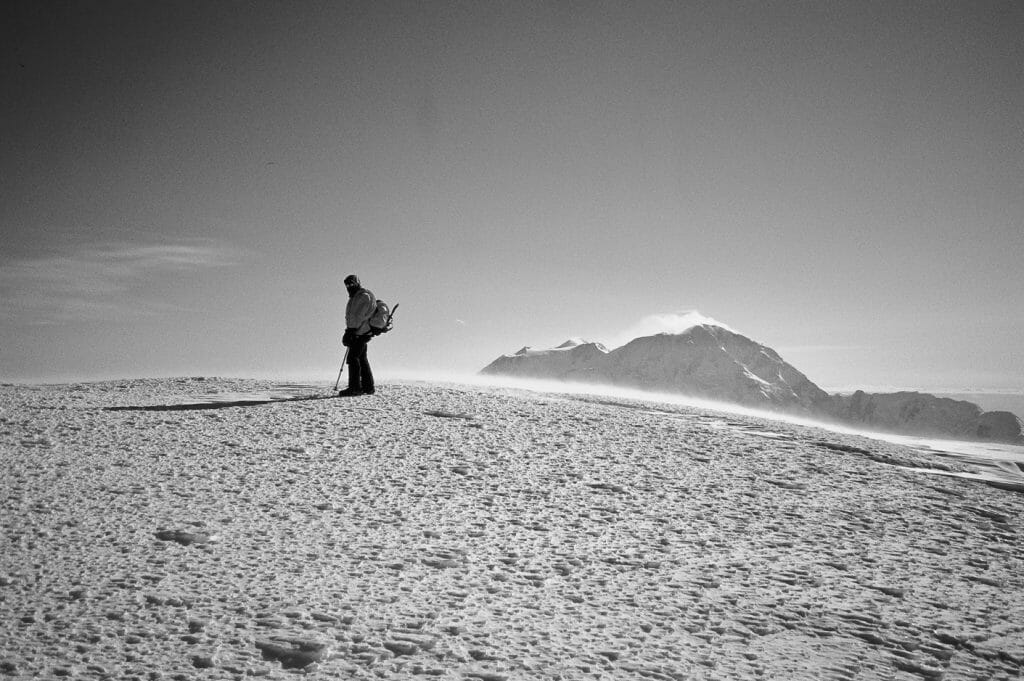In keeping with Steve’s recent article about wearing through your gear to become a better climber, runner, or skier, here is another tip that you may find useful: The magnitude of your commitment must be equal to the size of your goal.
Let’s start by looking behind the curtain at what three very successful Uphill Athletes’ training looks like.
Luke Nelson
First up: Luke Nelson. Luke is a mountain runner and skimo racer par excellence. Most recently, he and Jared Campbell knocked over 3 hours off the FKT for all 19 of the 13,000 foot peaks in Utah’s Uinta Mountains, covering 58 miles and 22,000 vertical feet in less than 33 hours. Extracting Luke’s totals for training time, elevation, and mileage from his TrainingPeaks log, we found the following statistics:
- Total annual training hours: 650
- Average training time per week: 12:30 hours/week, including a monthlong break. He had 3 weeks over 40 hours and 11 weeks over 23 hours.
- Average elevation gain and loss/week: 9,843 feet/week, with 6 weeks over 20,000 feet and 17 weeks over 15,000 feet.
- Mileage: 55 miles/week, with 7 weeks over 100 miles and 25 weeks over 75 miles.
David Goettler
Next let’s take a look at the past year log for top alpinist David Goettler. David and his partner recently completed a single-day climb of the Girona Route on the south face of Shishapangma, climbing from the base of the face at 5,900 meters to just 5 meters below the summit in only 13 hours. (They didn’t climb the last 5 meters to the top because they deemed the risk of avalanche unacceptable.)
- Total training hours: 767.
- Average training time per week: 14:45 hours/week, including 4 weeks of less than 6 hours/week and 10 weeks over 20 hours.
- Average elevation gain and loss/week: 11,474 feet/week, with 10 weeks over 16,000 feet and 4 weeks over 20,000 feet.
- Mileage: 42.6 miles/week, with 11 weeks over 60 miles.
Kilian Jornet
Finally: Kilian Jornet. Kilian has had an amazing year thus far, but in our opinion it is his complete career to date that is so impressive. Let’s review a few of his important training facts:
- He completed an 80-kilometer foot race when he was 12 years old.
- He logged over 600 hours of training time the year he turned 13.
- In every year since he turned 17 years old he has completed between 1,000 and 1,200 training hours annually. (He will turn 30 in a few months.)
- He has 13 years of training in excess of 1,000 hours per year under his belt.
- He overtrained once but caught it early so that he only needed a two-week break.
As readers of this site will know, that kind of long-term training volume can support a huge amount of utilization, which means dreams fulfilled.
Not everyone can or should be like Luke, David, or Kilian. And, to be clear, a fit weekend warrior who tries to replicate any of these years of training of any of these three athletes simply could not do it. Period. You have to build up to that kind of training load over years. And, as Kilian himself says, the first year of training is simply the time spent getting to know your body.
Balancing the Dream and the Commitment
Back in January, Steve wrote the following:
“Everyone knows that simply having a dream isn’t a guarantee that it will come true. But what many people forget is that not having a dream, and working to translate that dream into an achievable goal, is a guarantee that it won’t come true.”
Goals do stage outcomes. Yet we hear from many people seeking high-end goals in what are untenable timelines. They’re big on dream, small on commitment. You do not climb the biggest, hardest, longest, and highest mountains in one year. The dream and the commitment must balance.
Here is a thought-experiment: If a non-skier came to Scott Johnston, coach to several Olympic ski athletes, and said he wanted to ski in the next Olympics but had never skied, didn’t have much time to train, and was 55 years old with bad knees, it seems quite reasonable to dissuade this person. But, especially in mountaineering and particularly with regards to Mount Everest, this is what people have asked of themselves, and us. Olympic-size goals are the process of a lifetime, or at least a decade or two. Remember “The Truth About Training”?
So dream. Yes. But if your dreams are big, you’d better understand that your commitment, both in terms of time and energy, must be equally large. So what can we can learn from Kilian, David, and Luke? We say this: Do not lose yourself in awe over those athletes’ accomplishments. Lose yourself in awe over their commitment. Their discipline. Their vision to envision the goal, and to actually understand what realizing that dream means, and to make that dream a reality by giving themselves every opportunity to make their goals reality.
So, Is Your Dream Too Big for Your Commitment?
If you are ready to hear an honest opinion as to whether your climbing, mountaineering, ski mountaineering, skimo racing, or mountain running goals are reasonable, then we’re here to give you our honest, candid, no-bullshit opinion. Email us at coach@uphillathlete.com.
-by Steve House and Scott Johnston, Uphill Athlete co-founders

